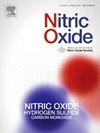Hydrogen sulfide upregulates SIRT1 to inhibit ox-HDL-induced endothelial cell damage and mitochondrial dysfunction
IF 3.2
2区 生物学
Q2 BIOCHEMISTRY & MOLECULAR BIOLOGY
引用次数: 0
Abstract
Background
Under normal circumstances, high-density lipoprotein (HDL) is considered to have cardiovascular protective effects, but the impact of oxidized HDL (ox-HDL) on vascular endothelial function remains poorly understood. Mitochondrial function is closely related to endothelial function, and hydrogen sulfide (H₂S) is a gas with endothelial protective properties. The novel hydrogen sulfide donor AP39 can target mitochondria to release H₂S, but the combined effects of ox-HDL and AP39 on vascular endothelium are not well studied.
Methods
We established a cell model of ox-HDL-induced endothelial cell damage and mitochondrial dysfunction using human umbilical vein endothelial cells (HUVECs) and conducted AP39 pretreatment. The experiments confirmed the functional damage and mitochondrial dysfunction in HUVECs caused by ox-HDL. Additionally, to further explore the role of SIRT1 in AS, we analyzed SIRT1 expression in AS carotid artery tissue. This included the analysis of differentially expressed genes from AS-related datasets, presented through volcano plots and heatmaps, with enrichment analysis of downregulated genes in KEGG pathways and GO functions. Furthermore, we evaluated the differences in SIRT1 expression in coronary arteries with varying degrees of stenosis and in early and late-stage AS carotid artery tissues, and analyzed data from SIRT1 knockout mouse models.
Results
The experimental results indicate that AP39 effectively alleviated ox-HDL-induced endothelial cell damage and mitochondrial dysfunction by upregulating SIRT1 expression. MTT and CCK-8 assays showed that ox-HDL treatment led to decreased cell viability and proliferation in HUVECs, reduced eNOS expression, and significantly increased levels of ICAM-1, IL-6, and TNF-α, along with enhanced monocyte adhesion. These findings reveal the damaging effects of ox-HDL on HUVECs. Transcriptomic data indicated that while SIRT1 expression did not significantly differ in coronary arteries with varying degrees of stenosis, it was notably downregulated in AS carotid artery tissues, especially in late-stage AS tissues. KEGG pathway enrichment analysis revealed that SIRT1 downregulated genes were associated with processes such as vascular smooth muscle contraction, while GO analysis showed that these downregulated genes were involved in muscle system processes and muscle contraction functions, further confirming SIRT1's critical role in AS pathology. In transcriptomic data from the SIRT1 knockout mouse model, elevated levels of inflammation-related proteins IL-6 and TNF-α were observed after SIRT1 knockout, along with decreased expression of the chaperone protein PGC-1α. The expression of mitochondrial-related functional proteins Nrf2 and PGC-1α was positively correlated with SIRT1 expression, while inflammation-related proteins ICAM-1, IL-6, IL-20, and TNF-α were negatively correlated with SIRT1 expression. We further discovered that ox-HDL triggered mitochondrial dysfunction, as evidenced by reduced expression of Mfn2, Nrf2, PGC1-α, UCP-1, and SIRT1, corroborating the results from the previous database analysis. Additionally, mitochondrial dysfunction was characterized by decreased mitochondrial membrane potential (MMP), increased mitochondrial ROS levels, and reduced ATP content, further impacting cellular energy metabolism and respiratory function. Subsequent experimental results showed that the addition of AP39 mitigated these adverse effects, as evidenced by decreased levels of ICAM-1, IL-6, and TNF-α, increased eNOS expression, reduced monocyte adhesion, increased mitochondrial H₂S content, and upregulated expression of SIRT1 protein associated with mitochondrial function, reduced ROS levels, and increased ATP content. Furthermore, validation experiments using the SIRT1 inhibitor EX527 confirmed that AP39 alleviated ox-HDL-induced endothelial cell damage and mitochondrial dysfunction by upregulating SIRT1 expression.
Conclusion
Ox-HDL can induce damage and mitochondrial dysfunction in HUVECs, while AP39 inhibits ox-HDL-induced endothelial cell damage and mitochondrial dysfunction by upregulating SIRT1.
硫化氢上调 SIRT1 以抑制氧化-HDL 诱导的内皮细胞损伤和线粒体功能障碍
背景:在正常情况下,高密度脂蛋白(HDL)被认为具有保护心血管的作用,但氧化高密度脂蛋白(ox-HDL)对血管内皮功能的影响仍鲜为人知。线粒体功能与内皮功能密切相关,而硫化氢(H₂S)是一种具有保护内皮功能的气体。新型硫化氢供体 AP39 可靶向线粒体释放 H₂S,但氧化-HDL 和 AP39 对血管内皮的联合影响尚未得到充分研究:方法:我们利用人体脐静脉内皮细胞(HUVECs)建立了氧化-HDL 诱导内皮细胞损伤和线粒体功能障碍的细胞模型,并进行了 AP39 预处理。实验证实了 ox-HDL 对 HUVECs 造成的功能损伤和线粒体功能障碍。此外,为了进一步探讨 SIRT1 在强直性脊柱炎中的作用,我们分析了强直性脊柱炎颈动脉组织中 SIRT1 的表达。这包括通过火山图和热图分析 AS 相关数据集中的差异表达基因,以及 KEGG 通路和 GO 功能中下调基因的富集分析。此外,我们还评估了不同狭窄程度的冠状动脉以及AS早期和晚期颈动脉组织中SIRT1表达的差异,并分析了SIRT1基因敲除小鼠模型的数据:实验结果表明,AP39能通过上调SIRT1的表达有效缓解氧化-HDL诱导的内皮细胞损伤和线粒体功能障碍。MTT 和 CCK-8 检测表明,氧化-HDL 处理导致 HUVECs 细胞活力和增殖下降,eNOS 表达减少,ICAM-1、IL-6 和 TNF-α 水平显著升高,单核细胞粘附性增强。这些发现揭示了氧化-HDL 对 HUVEC 的破坏作用。转录组数据表明,虽然SIRT1的表达在不同狭窄程度的冠状动脉中没有显著差异,但在AS颈动脉组织中,尤其是在AS晚期组织中,SIRT1的表达明显下调。KEGG通路富集分析表明,SIRT1下调基因与血管平滑肌收缩等过程有关,而GO分析表明,这些下调基因参与了肌肉系统过程和肌肉收缩功能,进一步证实了SIRT1在强直性脊柱炎病理中的关键作用。在SIRT1基因敲除小鼠模型的转录组数据中,观察到SIRT1基因敲除后炎症相关蛋白IL-6和TNF-α的水平升高,以及伴侣蛋白PGC-1α的表达下降。线粒体相关功能蛋白 Nrf2 和 PGC-1α 的表达与 SIRT1 的表达呈正相关,而炎症相关蛋白 ICAM-1、IL-6、IL-20 和 TNF-α 则与 SIRT1 的表达呈负相关。我们进一步发现,氧化-HDL 会引发线粒体功能障碍,表现为 Mfn2、Nrf2、PGC1-α、UCP-1 和 SIRT1 的表达减少,这证实了之前数据库分析的结果。此外,线粒体功能障碍表现为线粒体膜电位(MMP)降低、线粒体 ROS 水平升高和 ATP 含量降低,进一步影响了细胞的能量代谢和呼吸功能。随后的实验结果表明,添加 AP39 可减轻这些不利影响,具体表现为 ICAM-1、IL-6 和 TNF-α 水平降低,eNOS 表达增加,单核细胞粘附性降低,线粒体 H₂S 含量增加,与线粒体功能相关的 SIRT1 蛋白表达上调,ROS 水平降低,ATP 含量增加。此外,使用 SIRT1 抑制剂 EX527 进行的验证实验证实,AP39 通过上调 SIRT1 的表达,减轻了氧化-HDL 诱导的内皮细胞损伤和线粒体功能障碍:结论:氧化-HDL 可诱导 HUVECs 损伤和线粒体功能障碍,而 AP39 可通过上调 SIRT1 抑制氧化-HDL 诱导的内皮细胞损伤和线粒体功能障碍。
本文章由计算机程序翻译,如有差异,请以英文原文为准。
求助全文
约1分钟内获得全文
求助全文
来源期刊

Nitric oxide : biology and chemistry
生物-生化与分子生物学
CiteScore
7.50
自引率
7.70%
发文量
74
审稿时长
52 days
期刊介绍:
Nitric Oxide includes original research, methodology papers and reviews relating to nitric oxide and other gasotransmitters such as hydrogen sulfide and carbon monoxide. Special emphasis is placed on the biological chemistry, physiology, pharmacology, enzymology and pathological significance of these molecules in human health and disease. The journal also accepts manuscripts relating to plant and microbial studies involving these molecules.
 求助内容:
求助内容: 应助结果提醒方式:
应助结果提醒方式:


